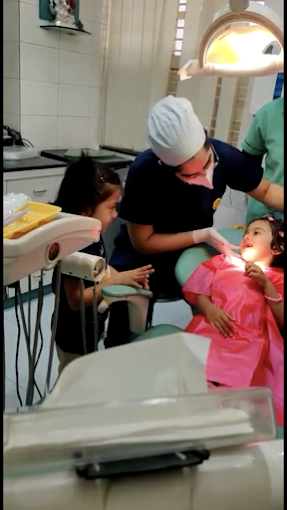Pulp therapy for children
In Pune
Pulp therapies in children are dental procedures designed to address issues related to the pulp (the innermost part of a tooth containing nerves and blood vessels) in primary (baby) teeth. There are several types of pulp therapies used in pediatric dentistry, each with its specific indications and techniques.

After a clinical and radiographic evaluation, we tentatively decide the course of action for your child’s cavitated tooth. So unless your child complains of spontaneous pain, pain at night, or has landed with acute swelling. We can Avoid the Root Canal treatment In Pune for your child’s teeth by following a selective cavity removal technique.
We at Dr. Tooth – The Best Dental Clinic in Pune offer Root Canals Treatment for children in Pune.

Why Radiographs
are important?
What you as parents see in your child’s mouth is just the tip of the iceberg, and a radiograph helps us give a clear picture with regards to the depth of the cavity, How close it is to the nerve, the position of the developing permanent bud, restorability of the tooth, and a lot more. However, an IOPA/Radiograph is a two-dimensional picture of a three-dimensional structure, hence most of the time whether to be conservative and do an Indirect Pulp Treatment IPT, or go ahead and a pulpotomy treatment or complete the Pulpectomy root canal treatment procedure. Let’s understand one at a time.
Pulpectomy
A pulpectomy is performed when the infection or decay has spread throughout the entire pulp, affecting both the crown and the root canals of a primary tooth.
In a pulpectomy, the dentist removes all of the pulp tissue, both in the crown and the roots.
After the pulp is removed, the root canals are cleaned, disinfected, and filled with a biocompatible material, typically gutta-percha.
A stainless steel crown is placed to cover and protect the tooth.
Pulpotomy
A pulpotomy is a common and relatively simple pulp therapy used when decay or infection has reached the pulp chamber in the crown portion of the tooth.
During a pulpotomy, the dentist removes the diseased or infected pulp tissue from the crown while leaving the healthy pulp in the root canals intact.
The remaining pulp is typically treated with a medicated dressing to promote healing and disinfection, and the pulp chamber is sealed.
A stainless steel crown is often placed over the tooth to restore its function and protect it.
Indirect Pulp Therapy
IPT
Indirect pulp therapy is used when there is deep decay near the pulp but the pulp itself is not yet involved or only mildly affected.
In this procedure, the dentist removes the decayed portion of the tooth and places a special medicated material over the remaining affected dentin.
The medicated material helps to stimulate the tooth’s natural healing and protective mechanisms.
A stainless steel crown may be placed to protect the tooth if there is a significant loss of tooth structure.
Direct Pulp Capping
DPC
Direct pulp capping is performed when there is a small exposure of the pulp, typically due to trauma or deep decay.
In this procedure, the exposed pulp is covered with a dental material to help stimulate healing and create a seal to prevent infection.
It is a more conservative approach used when the pulp is not significantly affected.
The choice of pulp therapy depends on the extent of pulp involvement, the child’s age, and the tooth’s overall condition. These procedures aim to save the primary teeth, alleviate pain, and maintain oral health and proper dental development until the child’s permanent teeth come in. Regular dental check-ups are essential to monitor the success of pulp therapy and ensure the child’s ongoing dental health.


